Bridging the generational gap
April 6, 2023
“What country is that?” her father asked in confusion.
What he was referring to wasn’t an image of a remote territory or symbolic souvenir. He was referring to a pansexual flag his daughter, Ciara Robinson (‘24) had hanging in her room.
Robinson, who is pansexual, has grown up in a family with strong ties to church that leans towards homophobic standpoints.
“My mom grew up going to church every Sunday and the idea that ‘gay people go to hell’ is instilled in her mind,” she said. As a result of these cultural and generational differences, Robinson says, although her parents are working to become open-minded, many members of her family still do not fully understand or support the LGBTQ+ community to which she belongs.
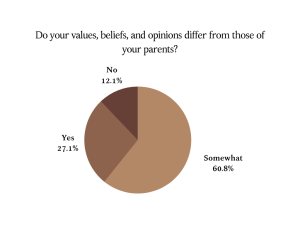
In an Eastside survey answered by 140 Cherry Hill High School East students, many students have reported similar chasms between their viewpoints and those of older family members. In the survey, 87.8% of respondents felt that their beliefs, values, and opinions differed at least somewhat from that of their parents. This proportion increased regarding grandparents: 92.9% of respondents said that their beliefs, values, and opinions differed from their grandparents to some degree.
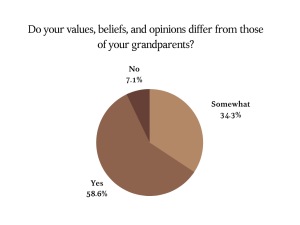
Such statistics reveal the extent of the generational gap: the great disparity between the beliefs and behaviors of older generations versus younger ones. To fully understand the consequences of these generational differences, we must also understand why it exists in the first place.
Today’s society is a diverse one — not only in terms of race, gender, religion, and economic backgrounds, but also in terms of age. Grouping society into generations allows individuals to belong to a collective of others who are generally at the same stage in life (eg. teenager, middle-aged adult, retiree) and have lived through the same major historical events.

Although there is no specific, designated point where one generation ends and another begins, today’s individuals have generally been grouped into these six generations: the Silent Generation (individuals born approximately 1945 or before), Baby Boomers (individuals born between 1946-1964), Generation X (born between 1965-1980), Millennials (born between 1981-96), Generation Z (born between 1997-2012), and Generation Alpha (born between 2012 to present).
Each of these generations has been shaped by dissimilar social, political, and economic climates, resulting in contrasting values, beliefs, and ideals. For example, the Silent Generation is a generation marked by the occurrences of World War II and the Great Depression, while Generation X has been strongly influenced by events such as Watergate, the AIDS epidemic, and the dot-com bubble. This is important because, according to The New York Times, the period of time between ages 14 and 24 is the most influential in the shaping of our personal ideologies. While that’s not to say that one’s beliefs stay stagnant into adulthood and old age — they certainly can change — it is shown that the events that we experience before we are 18 are three times more powerful and formative as those at age 40, according to a model of presidential voting created by researchers at Catalist, a Democratic data firm, and Columbia University.
Consequently, the generational diversity of today’s society plays a major role in the political and ideological divides that we face today. For East students, these generational differences are most apparent in their relationships with their parents and grandparents, manifesting themselves in discussions about technology, discrimination, mental health, politics, pop culture, as well as more.
Technology
Today’s teenagers, Generation Z, are the first generation to have grown up on the Internet. While older generations may see modern technology as an unwelcome distraction, most current high schoolers have never known a world without smartphones or social media. The tech industry has become bigger than ever and while the young are experts when it comes to keeping up the constant flow of new products and updates, this technological revolution has left many older generations behind.
“It is not that they won’t figure out how to use it, it’s that it is going to take them longer… As you get older, your fluid intelligence decreases so your reasoning, problem solving skills, [and] your speed at which you can pick up new skills decreases. And so for older generations, it is a lot more overwhelming than it is for younger [people],” said Mrs. Orlando, an AP Psychology teacher at East.
“My granddad called me at 10 at night to ask what cloud storage was,” wrote one student.
“My grandma talks to my mom on the landline every week,” wrote another. “We have tried to show her the ways of an iPad or a normal iPhone but due to a generational gap, she could not adapt.”
According to a 2016 Pew Research Center study, 80% of individuals aged 65 years or older have some sort of cell phone, but only 42% use smartphones. Furthermore, Pew Research Center studies also show that today, only about 45% of Americans aged 65 and older use social media, compared with 84% of individuals ages 18 to 29 and 81% of those ages 30 to 49. Thus, the trite image of the social-media obsessed teen, eyes constantly glued to their phone, has evolved into a popular stereotype for Gen Z.
“At home everything is blamed [on] my phone. If I make a mistake, it’s because of my phone. If I get a bad grade, it’s because of my phone,” one student wrote.
Another student wrote, “When my grandfather was alive, he was not a fan of kids having cell phones until the age of 18. He didn’t know how to use his [phone] that well so he would often get mad if I was on mine at all.”
Gen Z’s familiarity with technology may also be part of the reason why the divergence between the viewpoints of the young and the old has been so drastic over recent years. With the rise of social media, kids are becoming increasingly exposed to the outside world — to new ideas and opinions — at increasingly young ages. The stances our parents no longer hold as much precedence in defining our personal ideologies.
Discrimination
In a world constantly swept up in the current of change, the society in which current East students have grown up in is drastically different from that of their parents and grandparents. Subsequently, Gen Z, a population actively pursuing change to break past rigid sociocultural norms, is found face to face with older generations that learned to accept those very same norms.
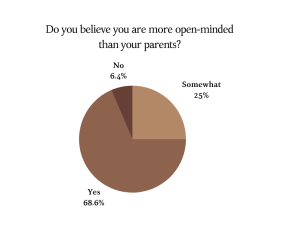
Throughout recent years, there has been marked change and advocacy for the rights of LGBTQ+ people and a breaking of the conventional binary for sexual orientation that was forcibly perpetuated for generations. Because of these changes, many people from preceding generations view the recent process towards inclusivity as an attack against their customary beliefs.
“[Older generations] feel as though this generation (Gen Z) is trying too hard to be different, and are making too many “edits” to society that are more complicated than need be,” wrote one student.
In terms of gender equality, on the surface, it may seem that our society has come a long way: recent generations have redefined gender norms and relationships. However, old habits die hard and if the overturning of Roe v. Wade provides any indication, traditional gender norms and still hold a strong presence in today’s politics and society.
The idea of marriage is one prominent point of disagreement among older and younger generations. While today’s youth have developed diverse ideas about family structure, many older individuals still cling to the traditional ideals: a mother, a father, and children.
“I had a discussion with an adult and they [insisted] that I would change my mind about not pursuing a marriage and not wanting biological children,” wrote one student.
This black and white view also discounts people who do not neatly fit into the traditional two-box view of gender. Sexist ideologies continue to additionally pervade in the binarization of “masculine” and “feminine” activities, a dichotomy still reinforced from past generations.
“I am an athlete and I’d say I workout somewhat often, which is a concept my grandmother, who is 93, finds completely obscure because she views fitness and sports as masculine activities,” wrote a student.
Many members of Gen Z have worked to push to evoke change in breaking traditional impeding beliefs. Part of the reason younger generations may be more tolerant and accepting towards different identities is because the very society we’ve grown up in is more diverse. In the U.S., the diversity in generations is only increasing. According to the Pew Research Center, Millennials are the most racially and ethnically diverse adult generation in history — and Generation Z, the next generation, is even more so. Today’s world is a combination of different cultures and backgrounds, constantly exchanging ideas and interacting with one another. However, this wasn’t always the case.
“My grandmother talked about growing up in Trenton where every different religious/cultural sect (she is Polish) lived in different areas and only met occasionally,” wrote one student. “Now, people are so much more integrated with their community and aren’t split into different sectors like that.”
Gen Z’s fight for inclusivity also echoes a larger perception of open-mindedness among the population. In a survey of 140 East students, 68.6% of students responded that they believed that they were more open-minded than their parents and 79.3% said that they were more open-minded than their grandparents.
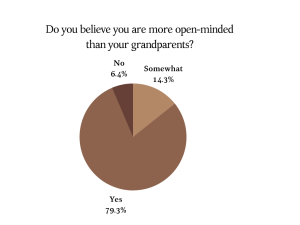
“Any homophobic or racial comments that someone older than me (at home and in the classroom) has made [are] based on nothing but simply ignorance and the need to fit into the “society” that they were brought up in. It’s almost impossible to explain to those individuals why their remarks are not okay or acceptable, and how they have such an unawareness for their surroundings and how their comments can affect younger individuals,” one student wrote.
This is largely explained due to how accustomed attitudes on principal topics — for instance, race — have transformed significantly over time. Brookings Education reports that between 1958 and now, if a Black family moved to be someone’s next-door neighbor, 44% to now 1% would move, and between 1964 and now, 18% to 86% of white people say they have a Black friend. While this demonstrates an incumbent shift towards more inclusive views, it also demonstrates a significant gap between racial ideologies throughout time. Yet, again, as views shifted and norms transfigured, some people were left in the past, transfixed in the values that society once accepted.
“My grandmother often makes jokes in reference to other races and skin colors and has negative perceptions of different races,” one student wrote.
This misunderstanding of how the tides of change have risen in support for marginalized and misunderstood groups, have left members of one generation pushing for greater waves and members of other generations holding up crumbling walls.
Mental Health
For many immigrant parents or grandparents that were subjected to harsh standards and expectations based on their country’s culture, they feel the necessity to inflict the same type of pressure on their children and grandchildren– a pressure with severe physical and emotional consequences.
“My parents believed physical punishment was an acceptable form of discipline because it was what they grew up with in Korea,” one student wrote.
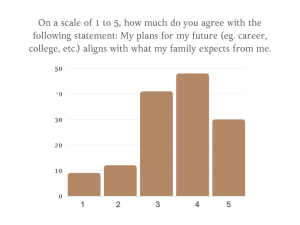
This pressure often manifests itself into academic pressure– usually seen through older generations beseeching on younger generations to achieve pristine grades and gain acceptance into elite colleges and universities. Mirroring the acute focus many countries place on scores and examinations, older generations that come from these backgrounds similarly pressure younger generations to have a steadfast focus on academic achievement, often leading to toxic competition to perform well academically, many times at the expense of mental health.
“Especially now, there is a very different mindset regarding the path to college and [its effect] on teenage mental health. I think people are so much more aware of the insanely competitive environment and try to focus on happiness whereas before, people tried to do everything in order to get into top schools. Because of this different mindset, a generational difference exists in the way we look at how students should be performing in the classroom,” wrote one student.
According to the Center for Disease Control (CDC), one in five children, either currently or at some point during their life, have had a seriously debilitating mental illness. Yet, in today’s society, if such an individual were to reach out for help, it is all too likely that they would be met with dismissiveness and even blame.
“[My parents and grandparents] view [mental health] as a first world problem… [it] is something that ‘is a you problem’, that isn’t serious at all and is something that simply makes one weak,” wrote one student. “When I got diagnosed with depression, my parents immediately told me and argued with the doctor that nothing was wrong with me and that I simply just have ‘too many emotions.’”
Growing up, older generations were taught that mental health struggles were a sign of weakness, and to just “get over” their troubles. The taboo on mental health and therapy extends across generations and cultures, but with the recent rise of mental health awareness, it seems that it has finally begun to erode.
Politics
The cliche bears some truth: you sit down at your Thanksgiving dinner table and by the time you stand up again you’ve received another harangue about “politics today,” usually from an older family member.
When students were asked to expand on their experiences with generational differences, many explained such divergences are made apparent “when watching the news,” “during the presidential election,” “talking about politics at home,” and when “grandparents started to say things about politics during dinner.”

The political ideologies of different generations represent a larger movement for younger generations to follow more liberal views while shifting away from more conservative views, a trend that has been occurring for at least the past 20 years according to Nick Neauchamp, a professor at Northeastern University.
“I think one of the things that contributes to this is that adolescents, in terms of their thinking, will often experience… adolescence idealism. And it is this notion that as you are figuring out your identity and figuring out where you fit in the world you often pick up different causes and stand behind those. You are often very idealistic in your approach to handling rather complex situations. I think it is part of the cognitive development of adolescents,” said Orlando.
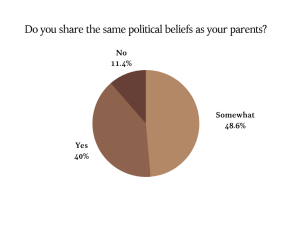
According to the Pew Research Center, most Millennials follow consistently or mostly liberal views. In comparison, the Silent Generation is the only generation where conservative views outweigh liberal views. As the two ideologies pull in opposite directions, not only is political polarization exacerbated but the divide between different generations as a whole widens, maybe so far that individuals can’t even see the other side.
“Access to media makes a difference. I think today more than ever you are able to gear your exposure to whatever your belief is. And there are algorithms that do that for you. If I’m more liberal in my beliefs and I’m scrolling through Twitter and TikTok and Facebook and those platforms, they are going to gear my exposure to go along with those interests that I have. In general, there is a split because now you don’t have to see both sides of the story… It is almost like confirmation bias. You are only looking for the stuff that confirms your belief,” said Orlando.
In today’s Congress, older generations of Generation X, Baby Boomers, and the Silent Generation still make up the majority of seats, making up approximately 35.3%, 48.8%, and 5.4% respectively. However, in recent years, the proportion of Millennial lawmakers in Congress has grown, from making up just 1% of the House in 2017 to 12% in 2023. Now, with Gen Z being eligible to run for Congress and the first Gen Z member of Congress, Maxwell Frost, elected in the November midterm elections, politics is becoming more generationally diverse. Perhaps with this increasing representation in government, more people will come to respect and compromise with the different political views of other generations.
Bridging divides

There’s a saying that “the only constant is change”: time changes, society changes, populations change, individuals change. Popularized ideologies and accepted conventions shift throughout time, but the effects of these changes are not created equal among different generations. As time progresses, older populations often remain stagnant — fixed in the views they were taught, closing themselves off to change. New generations emerge in a changing world, while old generations are stuck in the very world that needed changing.
Evidently, there remains a vast gap between different generations, one that is only expected to widen as more years pass. Yet, we will always be interconnected in some way. Approaching differences without comparison (“younger kids have it easier”) and contempt (“ok boomer”), but rather with mutual open-mindedness and empathy, can allow generations to connect with each other with understanding.
“I can’t speak for everybody, but I can just say [you can] love someone who doesn’t think the same way as you as long as they’re willing to try to listen and try to understand,” said Robinson.
She encourages students to have those tough conversations with their loved ones, even if they’re uncomfortable. Because even when religious, political, and overall ideological differences about identity or society as a whole can divide, they can also serve as a stepping stone for understanding.

“[My mother and I] have these very long car ride conversations about my friends’ pronouns and she takes a second and she thinks about it, and that’s what matters.”
Whether it’s because of these long car rides or interactions in the workplace or because we sit down at the same dinner table each night, generations find themselves coming together. And as we sit down, we carry with all of us unique values and beliefs, structured largely by the times we’ve experienced. Yet, when those fade away, universally human values and emotions are left behind, the values that are the bridge from one to another– love, family, hope, and all of the in between.
Time changes, but these core connections don’t have to. Sometimes you just have to extend your hand with the understanding that even with generations removed, the values that have stood the test of time in bringing humankind forward — love, family, hope, and kindness — will continue to bridge it together.
